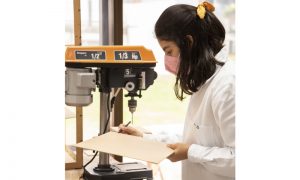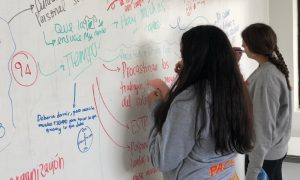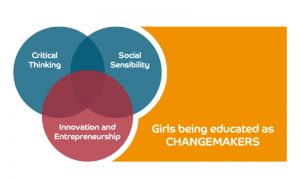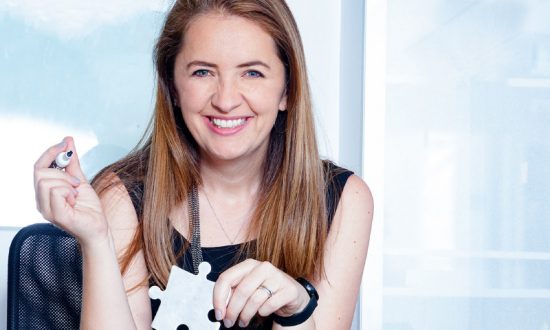Working on innovation and with entrepreneurs for over 12 years, Catalina discovered a passion: to develop creative, innovation and entrepreneurial skills from early ages. 5 years ago, she decided to dedicate her life to her passion, working as Leader of Innovation and Entrepreneurship at Colegio Santa Francisca Romana. Catalina has also started to build her consultancy agency on education to innovate, looking to move in education the importance of the development of skills needed to succeed in life.
In 2016 at Colegio Santa Francisca Romana, a girl’s school based in Bogotá Colombia, educational leaders sat down to talk about the future. The Zarza logo is accompanied by a slogan that says girls are taught in school to be light for the world. Why do students need to be light?
The school was founded in 1963 by five nuns from the Congregation of Our Lady of Lourdes in Rochester, Minnesota. For over 59 years, students have received an education based on Saint Francis’ values, developing a special awareness and sensibility on social issues. Critical thinking gives the students the abilities to understand the world and it takes them to rank year after year at the top spots at ICFES, the national exit test.
Principal Liliana Arango (2013-2021) was not happy on just continuing with what had been done, but making it better based on educational trends. It was clear that the world was moving faster and every year students needed tools to confront the everyday challenges of life, and the implications change had on their personal and professional paths.
The question became: what if there is something else that can be done to empower girls as changemakers?
One of the studies that gave answers, was the global competence for education presented by Veronica Boix Mansilla (2013). It helped to understand that content was not enough, it was more about how to enrich it with investigation and looking at different perspectives, communicating and on how to give students skills to take action over their ideas. You can study, get knowledge, but impact comes from when you take that knowledge, ideate, and take action over it. This way, students can be the light that ignites ideas that have an impact on the problems that surround our society.

Reading news and academic studies, having conversations and strategic planning meetings with parents, students and colleagues, started taking place at the school to define a vision for 2022 with five key objectives. The school had been working for years on four of the objectives, and there was one new factor to work on. By 2022 the school expected to be recognized as leader on innovation and entrepreneurship.
Girls with critical thinking and social sensibility, were now being given skills on innovation and entrepreneurship, so that they could see problems as opportunities, ideate, prototype, apply and take action, therefore becoming real changemakers.
Two factors where essential for bringing the idea to life:
Technology As a Key Factor: Understanding that teaching technology was not about word, excel, power point and paint documents, and this needed to be changed.
Create, Ideate and Take Action: Developing a curriculum to develop creativity, innovation, and entrepreneurial skills so that students could take ownership of their ideas and be committed to them to generate impact.
Technology As a Key Factor

Technology teaching had to be rethought. The head of the technology department Claudia Rojas, with her team, looked for trends and developed a whole new curriculum based on the exploration of the world of technology and making. Students develop programming skills (by blocks and pseudocode) and complemented them with the use of hand and electric tools, laser cutters and 3D printing, among others, thus making their ideas tangible.
The technology curriculum is taught from prekinder to 12th grade and is based on four main components:
Computational thinking: programming skills with the intention of developing in student skills on how to breakdown problems, propose and understand the process towards a result.
Artifacts: Understanding artifacts, how they work, and the different movements technology makes possible. Transmission and movement transformation, developing skills working with Arduino on circuits and automation.
Design and Office: The use of the office suite, but also graphic and industrial design, with specialized software, taking ideas to 3D printing and laser cutting.
Technology and society: Moral and ethics in technology, security, and personal care on the web. Legal implications and correct use of the resource for the common good.
Decisions and investment in developing new spaces to learn technology were fundamental. Taking the student out of a room full of computers, to work with tablets and laptops in different scenarios. Having a preschool maker space, as well as one for primary and high school, where students understood the use of tools to prototype their ideas.

This not only gave the technology department an opportunity to engage with new technological trends, but also to connect with Math and Science in the development of STEM-STEAM projects. As said before, students were open to the exploration of the contents, always considering the why? and what if? It gave them understanding on how their ideas can be put into action and the impact they have in society.
Photo footer: Students making, learning to work with different tools at the makerspace to make their ideas come to life
Create, Ideate and Take Action
One day, art teacher Leonardo Pinzon, gave 11th graders a white paper. Students waited for the instruction, and so Leonardo said: just let your creativity decide. That day Leonardo understood that students didn’t see themselves as creative people. At the same time principal Liliana Arango and technology teacher Juan Ramón González, were talking about creating a class in 9th grade about innovation. Bringing creativity and technology into building something, gave students the XXI Century skills of problem solving, creative thinking, teamwork, amongst others.
In august 2016 a new class was organized for 9th graders called Inn-Genius. During the next 6 years students have gone through 6 principles that define the Inn-Genius philosophy:
- The key is to build with others: Understanding strengths and weaknesses and looking for a team that complements them. The difference on doing the work as a team and not just with a group.
- See problems as opportunities: Day by day problems can be solved and have a direct impact on a person, improving their quality of life. Redefining problems as opportunities to act upon them.
- We are all creative: Defining that every person is creative and that it has very little to do with good drawing skills. Creativity seen as the power to project ideas in a tangible way.
- We must take action to impact: Having ideas is good but implementing them so that they can really have an impact in society makes them better.
- Value the process and its setbacks: It’s important to realize that every process is different and it comes with ups and downs. It’s in this roller-coaster were lessons have a bigger impact.
- Communicate your ideas to inspire: Learning how to inspire others by communicating ideas and invite them to give feedback so that the idea can evolve and be better.
Inn-Genius became powerful. Students were researching, interviewing the different perspectives on opportunities, developing ideas, communicating them, and taking action by building prototypes. They saw that their ideas were worth developing because they could give quality of life to a person, to a community, to our country, to the world.
Teams were solving opportunities such as:
- What if there was a way to protect a fracture without using crutches?
- What if we could fix a pavement hole with an ecofriendly and economical solution?
- What if we could get rid of the plastic in the shampoo packaging?
- What if trees can grow from clothes that are thrown to waste?
- What if we could make menstrual pads that can biodegrade faster?
The leader of innovation and entrepreneurship, Catalina Largacha, started working with teachers so that students could develop these skills before and after the 9th grade Inn-Genius experience. With her team they developed the Inn-Genius curriculum, with a clear path on developing imaginative, creative, innovative, and entrepreneurial skills on students from prekinder to 12th grade.
Imagination. Understanding the power of imagination, how the brain develops different images by mixing them to solve puzzles. Realizing that the images of one student are different from the other and how that is powerful when doing teamwork.
Creativity. Building creativity by exercising fluency, flexibility, originality, and idea elaboration. Recognizing human beings as creative and the power creativity has on ideas. Creativity being a process in which going blank is part of it.
Innovation. Taking design thinking as a process to create and develop ideas, thinking always on the instance that can be impacted by the idea. Understanding the value proposition of the solution and communicating it accurately, so that the innovation of the idea is recognized.
Entrepreneurship. Realizing that entrepreneurship is not just starting up a business but taking action over ideas. Having or not financial gain from it. Planning steps to move ideas forward.
What do students need from education, to be light? They need to be guided on what they can do with the contents they’re taught, so that they can impact society. Develop the skills to become changemakers in society.
Since January 2022, Maria del Rosario Concha became the new principal at the school, with a vision to keep building a continuous learning process. Every day is an opportunity to learn and develop the best education our students can receive.




